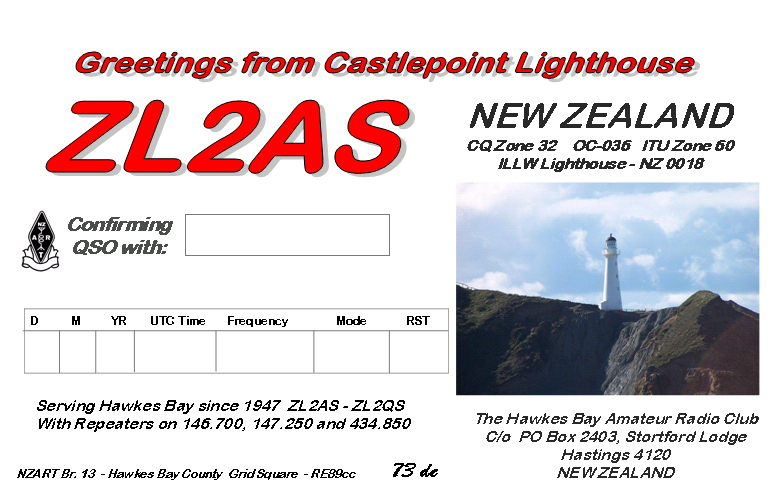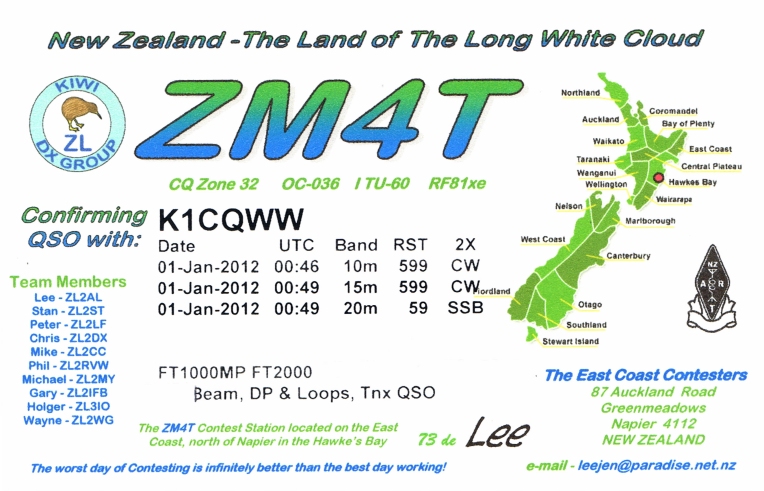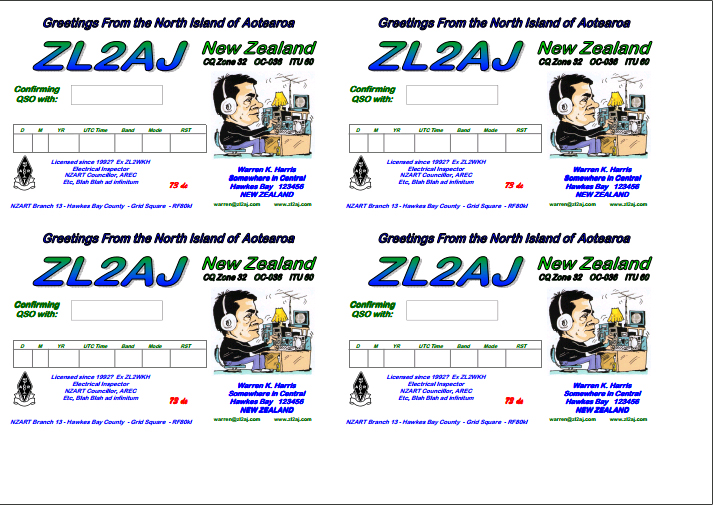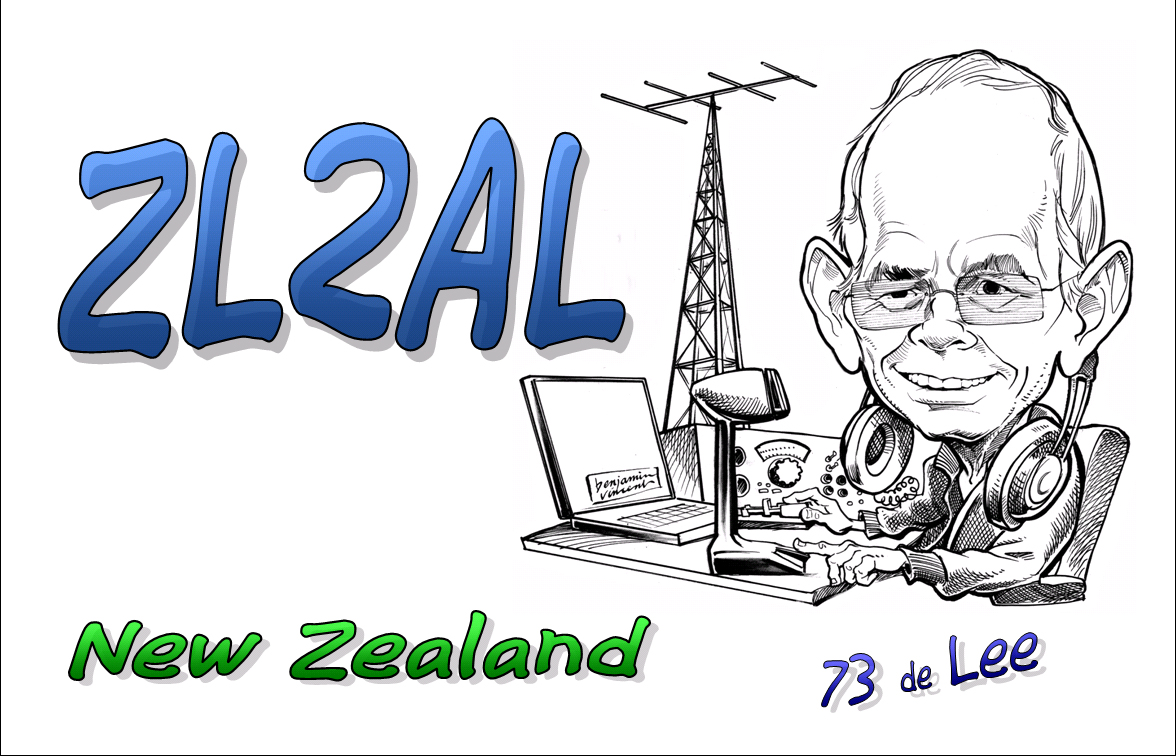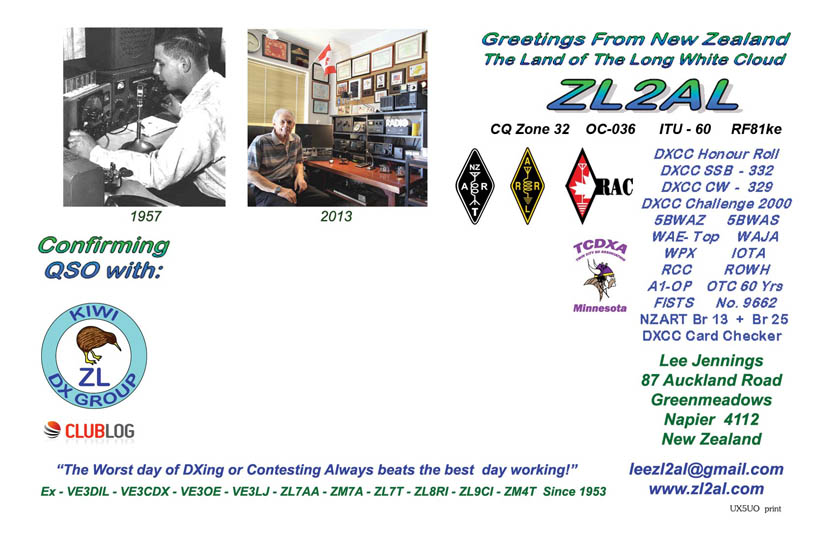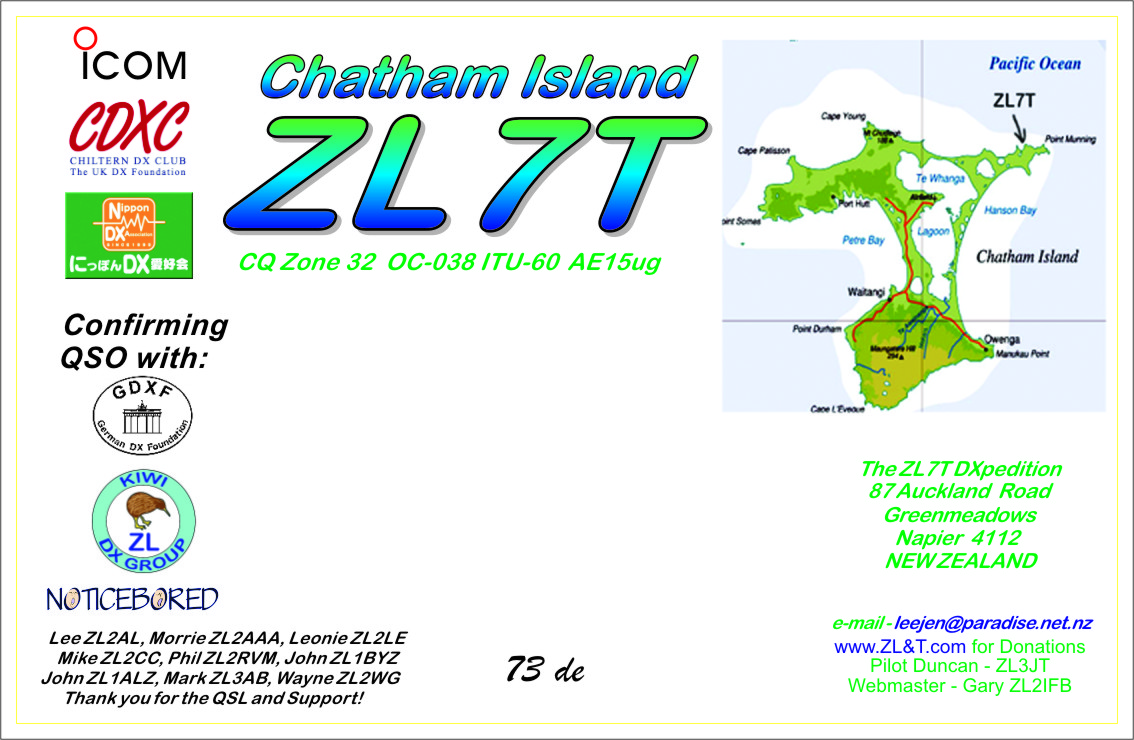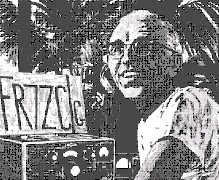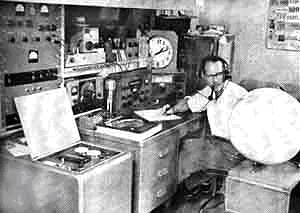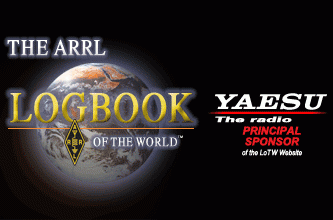THE G5RV ANTENNA, with its special feeder arrangement, is a multiband centre-fed antenna capable of very efficient operation on all hf bands from 3.5 to 28mhz, specifically designed with dimensions which allow it to be installed in gardens which accommodate a reasonably-straight run of about 102ft (31.1m) for the “flat-top”. However, because the most useful radiation from a horizontal or inverted-V resonant antenna takes place from the center two-thirds of its total length, up to one-sixth of this total length at each end of the antenna may be dropped vertically, semi-vertically, or bent at some convenient angle to the main body of the antenna without significant loss of effective radiation efficiency. For installation in a very limited space, the dimensions of both the “flat-top” and the matching section can be divided be a factor of two to make the half-size G5RV, which is a very efficient antenna from 7 to 28 mhz.
The full-size G5RV will also function on 1.8mhz band if the station end of the feeder (either balanced or coaxial-type) is strapped and fed by a suitable antenna tuner using a good earth connection or a counterpoise wire. Similarly, the half-size version may be used thus on 3.5 and 1.8 mhz bands.
In contradistinction to multiband antennas in general, the full size G5RV antenna was not designed as a half-wave dipole on the lowest frequency of operation, but as a 1 1/2 wave centre-fed long-wire antenna on 14mhz, where the 34ft (10.36m) open-wire matching section functions as a 1:1 impedance transformer, enabling the 75ohm twinlead or 50/80ohm coaxial cable feeder to “see” a close impedance match on that band with a consequently low vswr on the feeder. However,on all the other hf bands the function of this section is to act as a ” make-up” section to accommodate that part of the standing-wave (current and voltage components) which, on certain of the operating frequencies, cannot be completely accommodated on the “flat-top” (or inverted-V)radiation portion. The design centre frequency for the full-size version is 14,150khz, and the dimensions of 102ft (31.1m) is derived from the formula for long-wire antennas which is:
where n= number of half-wavelengths of the wire (flat-top).
In practice, since the whole system will be brought to resonance by the use of an antenna tuner, the antenna is cut to 102ft (31.1m).
As it does not make use of traps or ferrite beads, the “dipole” portion becomes progressively longer in electrical length with increasing frequency.This effect confer certain advantages over a trap or ferrite-bead loaded dipole because, with increasing electrical length, the major lobes of the vertical component of the polar diagram tend to be lowered as the operating frequency is increased. Thus, from 14mhz up, most of the energy radiated in the vertical plane is at angles suitable for dx working. Furthermore, the polar diagram changes with increasing frequency from a typical half-wave dipole pattern at 3.5mhz and a 2 1/2 wave in-phase pattern at 7 and 10mhz to that of a “long-wire” antenna at 14, 18, 21, 24 and 28mhz.
Figure 1.
Although the impedance match for 75 ohm twinlead or 80 ohm coaxial cable at the base of the matching-section is very good at 14mhz, and even the use of 50 ohm coax cable results in only about 1.8:1 vswr on this band, the use of a suitable antenna tuner is necessary on all the other hf bands because, on those bands, the antenna plus the matching-section will present a reactive load to the feeder. thus the use of the correct type of antenna tuner (unbalanced input to balanced output if twin-wire feeder is used, or unbalanced to unbalanced if coaxial feeder is used) is essential in order to ensure the maximum transfer of power to the antenna from a typical transceiver having a 50 ohm coaxial (unbalanced) output. Also to satisfy the stringent load conditions demanded by such modern equipment employing an alc system which “senses” the vswr condition presented to the solidstate transmitter output stage so as to protect it from damage which could be caused by a reactive load having a vswr of more than about 2:1.
Figure 2
The above reasoning does not apply to the use of the fullsize G5RV antenna on 1.8mhz, or to the use of the half-size version on 3.5 and 1.8mhz. In these cases the station end of the feeder conductors should be “strapped” and the system tuned to resonance by a suitable series-connected inductance and capacitance circuit connected to a good earth or counterpoise wire. Alternately, an “unbalanced-to-unbalanced” type of antenna tuner such as a “T” or “L” matching circuit can be used. Under these conditions the “flat-top” (or inverted-V) portion of the antenna plus the matching section and feeder function as a “Marconi” or “T” antenna, with most of the effective radiation taking place from the vertical, or near vertical, portion of the system; the “flat-top” acting as a top-capacitance loading element. However, with the system fed as described above, very effective radiation on these two bands is obtainable even when the “flat-top” is as low as 25ft (7.6m) above ground.
Theory of Operation
The general theory of operation has been explained above; the detailed theory of operation on each band from 3.5 to 28mhz follows, aided by figures showing the current standing wave conditions on the “flat-top” and the matching (or make-up) section. The relevant theorical horizontal plane polar diagrams for each band may be found in any specialized antenna handbooks. However, it must be borne in mind that: (a) the polar diagrams generally shown in two dimensional form are, in fact, three dimensional (ie solid) figures around the plane of the antenna; and (b) all theoretical polar diagrams are modified by reflection and absorption effects of near-by conducting objects such as wire fences, metal house guttering, overhead electric power and telephone wires, house electric wiring system, house plumbing systems, metal masts and guy wires, and large trees. Also the local earth conductivity will materially affect the actual polar radiation pattern produced by an antenna. Theoretical polar diagrams are based on the assumptions that an antenna is supported in “free space” above a perfectly conducting ground. Such conditions are obviously impossible of attainment in the case of typical amateur installations. What this means in practice is that the reader should not be surprised if any particular antenna in a typical amateur location produces contacts in directions where a null is indicated in the theoretical polar diagram and perhaps not such effective radiation in the directions of the major lobes as theory would indicate.
Figure 3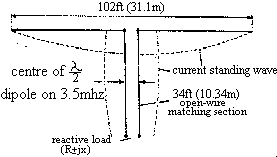
3.5Mhz. On this band each half of the “flat-top” plus about 17ft (5.18m) of each leg on the matching-section forms a fore-shortened or slightly folded up half-wave dipole. The remainder of the matching-section acts as an unwanted but unavoidable reactance between the electrical centre of the dipole and the feeder to the antenna tuner. The polar diagram is effectively that of a half-wave antenna. See figure 1.
7Mhz. The “flat-top” plus 16ft (4.87m) of the matching section now functions as a partially-folded-up “two half-wave in phase” antenna producing a polar diagram with a somewhat sharper lobe pattern than a half-wave dipole due to its colinear characteristics. Again, the matching to a 75 ohm twinlead or 50/80 ohm coaxial feeder at the base of the matching section is degraded somewhat by the unwanted reactance of the lower half of the matching section but, despite this, by using a suitable antenna tuner the system loads well and radiates very effectively on this band. See figure 2.
10Mhz. On this band the antenna functions as a two half-wave in-phase colinear array, producing a polar diagram virtually the same as on 7mhz. A reactive load is presented to the feeder at the base of the matching section but, as for 7mhz, the performance is very effective. See figure 3.
14Mhz. At this frequency the conditions are ideal. The “flat-top” forms a three-half-wave long centre-fed antenna which produces a multi-lobe polar diagram with most of its radiated energy in the vertical plane at an angle of about 14 degrees, which is very effective for dx working. Since the radiation resistance at the centre of a three-half-wave long-wire antenna supported at a height of half-wave above ground of average conductivity is about 90 ohm, and the 34ft (10.36m) matching section now functions as a 1:1 impedance transformer, a feeder of anything between 75 and 80 ohm characteristic impedance will “see” a non-reactive (ie resistive) load of about this value at the base of the matching section, so that the vswr on the feeder will be very nearly 1:1. Even the use of 50 ohm coaxial feeder will result in a vswr of only about 1.8:1. It is here assumed that 34ft (10.36m) is a reasonable average antenna height in amateur installations. See figure 4.
18Mhz. The antenna functions as two full-wave antennas fed in phase; combining the broadside gain of a two-element colinear array with somewhat lower zenith angle radiation than a half-wave dipole due to its long-wire characteristic. See figure 5
21Mhz. On this band the antenna works as a “long-wire” of five half-waves, producing a multilobe polar diagram with very effective low zenith angle radiation. Although a high resistive load is presented to the feeder at the base of the make-up section, the system loads very well when used in conjunction with a suitable antenna tuner and radiates very effectively for dx contacts. See figure 6.
24Mhz. The antenna again functions effectively as a five-half-wave “long-wire” but, because of the shift in the positions of the current anti-nodes on the flat-top and the matching section, as may be seen from figure 7, the matching or “make-up” section now presents a much lower resistive load condition to the feeder connected to its lower end than it does on 21mhz. Again, the polar diagram is multilobed with low zenith angle radiation.
28Mhz. On this band, the antenna functions as two “long-wire” antenna, each of three half-waves, fed in-phase. The polar diagram is similar to that of a three half-wave “long-wire” but with even more gain over a half-wave dipole due to the colinear effect obtained by feeding two three-half-wave antennas, in line and in close proximity, in-phase. See figure 8.
Construction
The Antenna
The dimensions of the antenna and its matching section are shown in Figure 9. The “flat-top” should, if possible, be horizontal and run in a straight line, and should be erected as high as possible above ground. In describing the theory of operation, it has been assumed that it is generally possible to erect the antenna at an average height of about 34ft (10.36m), which happens to be the optimum radiation efficiency on 1.8, 3.5 and 7mhz for any horizontal type antenna, in practice few amateurs can install masts of the optimum height of half a wavelength at 3.5 or 7mhz, and certainly not at 1.8mhz.
If, due to limited space available, or to the shape of the garden, it is not possible to accommodate the 102ft (31.1m) top in a straight line, up to about 10ft (3m) of the antenna wire at each end may be allowed to hang vertically or at some convenient angle, or be bent in a horizontal plane, with little practical effect upon performance. This is because, for any resonant dipole antenna, most of the effective radiation takes place from the centre two-thirds of its length where the current antinodes are situated. Near to each end of such an antenna, the amplitude of the current standing wave falls rapidly to zero at the outer extremities; consequently, the effective radiation from these parts of the antenna is minimal. The antenna may also be used in the form of an inverted-V. However, it should be borne in mind that, for such a configuration to radiate at maximum efficiency, the included angle at the apex of the V should not be less than about 120 degrees. The use of 14awg enameled copper wire is recommended for the flat-top or V, although thinner gauges such as 16 or even 18awg can be used.
The Matching Section
This should be, preferably, of open-wire feeder construction for minimum loss. Since this section always carries a standing-wave of current (and voltage) its actual impedance is unimportant. A typical, and very satisfactory, form of construction is shown in figure 10. The feeder spreaders may be made of any high-grade plastic strips or tubing; the clear plastic tubing sold for beer or wine siphoning is ideal.
If it is desired to use 300 ohm ribbon type feeder for this section, it is strongly recommended that the type with “windows” be used because of its much lower loss than that with solid insulation throughout its length, and its relative freedom from the “detuning” effect caused by rain or snow. If this type of feeder is used for the matching section, allowance must be made for its velocity factor (vf) in calculating the mechanical length required to resonate as a half-wave section electrically at 14.15mhz. Since the vf of standard 300 ohm ribbon feeder is .82, the mechanical length should be 28ft (8.5m). However, if 300 ohm ribbon with “windows” is used, its vf will be almost that of open-wire feeder, say .90, so its mechanical length should be 30.6ft (9.3m). This section should hang vertically from the centre of the antenna for at least 20ft (6.1m) or more if possible. It can then be bent and tied off to a suitable post with a length of nylon or terylene cord so as to be supported at above head-height to the point where, supported by a second post, its lower end is connected to the feeder.
The Feeder
The antenna can be fed by any convenient type of feeder provided always that a suitable type of antenna tuner is used. In the original article describing the G5RV antenna, published in the , then, RSGB bulletin November 1966, it was suggested that if coaxial cable feeder was used, a balun might be employed to provide the necessary unbalanced-to-balanced transformation at the base of the matching section. This was because the antenna and its matching section constitute a balanced system, whereas a coaxial cable is an unbalanced type of feeder. However, later experiments and a better understanding of the theory of operation of the balun indicated that such a device was unsuitable because of the highly reactive load it would “see” at the base of the matching or “make-up” section on most hf bands.
It is now known that if a balun is connected to a reactive load presenting a vswr of more than about 2:1, its internal losses increase, resulting in heating of the windings and saturation of its core (if used). In extreme cases, with relatively high power operation, the heat generated due to the power dissipated in the device can cause it to burn out. However, the main reason for not employing a balun in the case of the G5RV antenna is that, unlike un antenna tuner which employs a tuned circuit, the balun cannot compensate for the reactive load condition presented to it by the antenna on most of the hf bands, whereas a suitable type of antenna tuner can do this most effectively and efficiently.
Recent experiments by the author to determine the importance or otherwise of “unbalance” effects caused by the direct connection of a coaxial feeder to the base of the matching section had a rather surprising result. They proved that, in fact, the hf currents measured at the junction of the inner conductor or the coaxial cable with one side of the (balanced) matching section and at the junction of the outer coaxial conductor (the shield) with the other side of this section are virtually identical on all bands up to 28mhz, where a slight but inconsequential difference in these currents has been observed. There is, therefore, no need to provide an unbalanced-to-balanced device at this junction when using coaxial feeder.
However, the use of an unbalanced-to-unbalanced type of antenna tuner between the coaxial output of a modern transmitter (or transceiver) and the coaxial feeder is essential because of the reactive condition presented at the station end of this feeder which, on all but the 14mhz band, will have a fairly high to high vswr on it. This vswr, however, will result in insignificant losses on a good-quality coaxial feeder of reasonable length; say, up to about 70ft (21.3m). Because it will, inevitably, have standing waves on it, the actual characteristic impedance of the coaxial cable is unimportant, so that either 50 ohm or 80 ohm type can be used.
Another very convenient type of feeder that may be used is 75 ohm twinlead. However, because of the relatively high loss in this type of feeder at frequencies above about 7mhz, especially when it has a high vswr on it, it is recommended that not more than about 50 to 60ft (15.2 to 18.3m) of this type feeder be used between the base of the matching section and the antenna tuner. Unfortunately the 75 ohm twinlead in the UK is the receiver type; the much less lossy transmitter type is available in the USA. By far the most efficient feeder is the “open wire” type. A suitable length of such feeder can be constructed in exactly the same way as that described for the open-wire matching section. If this form of feeder is employed, almost any convenient length may be used from the centre of the antenna right to the antenna tuner (balanced) output terminals. In this case, of course, the matching section becomes an integral part of the feeder.
A particularly convenient length of open-wire feeder is 84ft (25.6m), because such a length permits parallel tuning of the antenna tuner circuit on all bands from 3.5 to 28mhz with conveniently located coil taps in the antenna tuner coils for each band, or, where the alternative form of antenna tuner employing a three-gang 500pf/section variable coupling capacitor is used the optimum loading condition can be achieved for each band. However, this is not a rigid feeder length requirement and almost any length that is mechanically convenient may be used. Since this type of feeder will always carry a standing wave, its characteristic impedance is unimportant, and sharp bends, if necessary, may be used without detriment to its efficiency. It is only when this type of feeder is correctly terminated by a resistive load equal to its characteristic impedance that such bends must be avoided.
Coaxial cable hf choke
Under certain conditions, either due to the inherent “unbalanced-to-balanced” effect caused by the direct connection of a coaxial feeder to the base of the (balanced) matching section, or to pick-up of energy radiated by the antenna, a current may flow on the outside of the coaxial outer conductor. This effect may be considerably reduced, or eliminated, by winding the coaxial cable feeder into a coil of 8 to 10 turns about 6in in diameter immediately below the point of connection of the coaxial cable to the base of the matching section. the turns may be taped together or secured by nylon cord.
It is important, of course, that the junction of the coaxial cable to the matching section be made thoroughly water-proof by any of the accepted methods; binding with several layers of plastic insulating tape or self-amalgamating tape and then applying two or three coats of polyurethane varnish, or totally enclosing the end of the coaxial cable and the connections to the base of the matching section in a sealant such as epoxy resin.
From RADIO COMMUNICATIONS, JULY 1984

